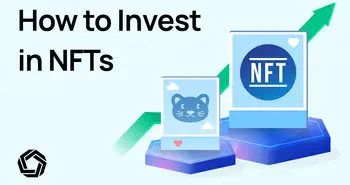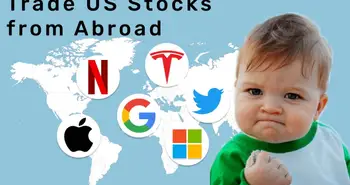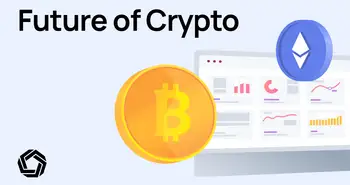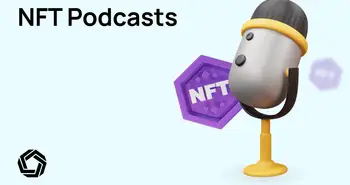How To Invest in Web3: A Comprehensive Guide

We want to start this blog with a quote from one of the most influential people and thinkers in tech:
“Things that look interesting to smart people usually do so because they are rich with product possibilities. These possibilities eventually become a reality. Toys become must-have tools. Weekend hobbies become mainstream activities. Cynics sound smart, but optimists build the future.”
Chris Dixon
In our humble opinion that is a big part of what awaits you in web3. When you look at new startups making their way into web3, it is, in fact, a bit overwhelming as it is not easy to understand how they are all categorized in one industry of web3:
- IYK inspires people to live in the moment by bridging immersive digital and physical experiences.
- FORMLESS™ is a creative technology lab headquartered in Cambridge, Massachusetts. We have domain expertise in Web3, AI, AR, embedded systems and media production.
- Morpher is a trading platform that creates a better trading experience for the investor in every dimension compared to traditional exchanges by giving people never seen before markets and tools.
Here are three web3 companies that could not be more different, but that is what it is about – there is not one direction where web3 is going. It is the complete opposite of looking at the paper industry, for example, where no innovation is happening, and “Dunder Mifflin” will slowly but surely go out of business. Yet, that is precisely why web3 is so exciting; it is the next step of the internet, currently being explored by the brightest minds worldwide.
In this blog post, we will try to give you a comprehensive overview of web3, from understanding the potential to showing you where to look for the best investments:
- Understanding the Disruptive Potential of Web3
- Who Are the Biggest Investors in Web3?
- Types of Web3 Investments You Can Choose From
- Some Risks and Considerations
- Due Diligence: Research Before You Invest in Web3
Understanding the Disruptive Potential of Web3
A lot of guides assume you already know everything about web3 and just throw random coins or projects at you that are the “next big thing”. However, this is not how proper investing works. The first rule every investor would tell you is to always know what you are investing in. As the topic is very complicated at first, we will try to explain the main idea of web3 in simple terms. Then, we will get more technical as the article progresses.
Think about it this way: it is the next stage of the internet. First, we had Web 1, then we had Web 2, and now we are progressing into Web 3.
- Web 1 was only a few websites where you could only “Read” content.
Web 2 was an era where you could create your own websites and content, so “Read” & “Write”, but you do not really own it, as you are at the mercy of big tech like Google and Facebook. - Web 3 is the era where you can “Read” & “Write” like in Web 2, but also verifiably “Own” your content and get paid accordingly thanks to tokens and the blockchain.
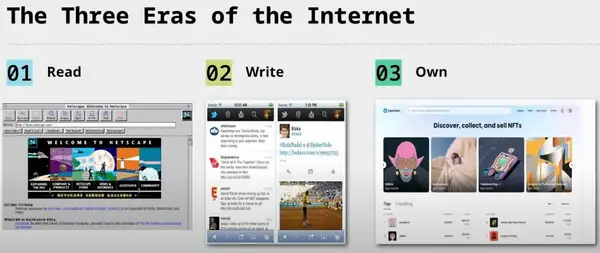
Source: a16z.com
Now let's go over an example to illustrate that idea even further.
Web1, the internet's early days, could be likened to a flea market—a bit chaotic, very democratic, and everyone had a booth. The products were, let's say, “artisanal.” You could get your hand-knit sweaters and Tupperware next to each other. The appeal was in the individuality and, dare we say, the lack of polish.
Web2, now you're walking through the corridors of a pristine shopping mall, complete with marble floors and an ambient playlist that someone insists improves shopper psychology. You've got your anchor stores—your Amazons and Googles—occupying the prime real estate. They make the rules; they reap the profits. It's standardized, organized, and decidedly top-down. You're there for the convenience, even if you don't exactly feel like you belong.
Now, let's engage in some retail futurism and envision Web3 as a co-op mall. A what? Yes, stick with us here. Imagine a shopping centre where every store is still independently run, but decisions about the mall's operations are made collectively. Store owners and frequent shoppers hold tokens, and these tokens aren't just a part of some rewards program offering you a free coffee after a dozen purchases. No, these tokens give you a vote on how the mall is run. Want to change the ambient playlist to 80s hits? Vote on it. Want to bring in a new store or feature? Put it to a token vote.
A great example of that would be Uniswap. It retroactively “airdropped” tokens to its early users as if to say, “Hey, thanks for being an early patron of our store; now have some say in how this place is run.” Could you imagine getting a letter from your local mall saying, “Thanks for shopping with us last Christmas. Here's 5% ownership of the food court”? It's like that but for internet services.
So, in this Web3 co-op mall, everyone with a token has skin in the game, leading to a more democratic, participatory shopping (or browsing) experience. The transition from a flea market to a corporate mall to a co-op mall captures the evolving ethos of the internet. It's the same mall, only now you might actually care about the playlist. In a way, web3 is rebuilding the internet from our perspective, the users' perspective. Web3 merges the decentralized, community-driven spirit of Web1 with the advanced functionality of Web2, all while giving users and builders a stake in the system through tokens.
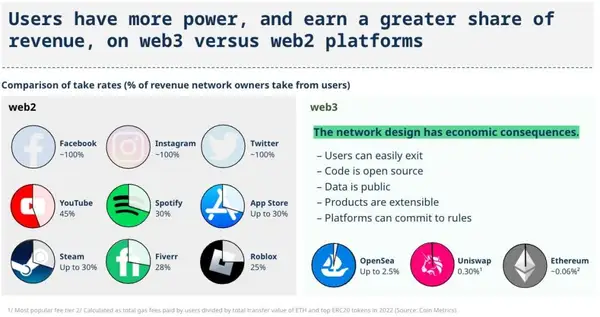
Source: a16z.com
The importance of Web3 lies in its attempt to address some inherent limitations of both Web1 and Web2. Web1, although decentralized and community-driven, was technologically limited; it couldn't offer the rich, interactive experiences that Web2 could. Web2, on the other hand, brought us those capabilities but at the cost of centralization. Centralization often leads to power imbalances, where a few big companies control the platforms and can act in ways that benefit them but maybe not the user or smaller businesses.
Why would you use Web3 over Web2?
In Web3, the control and ownership are distributed. Instead of one company owning the platform and making all the rules, users and builders can own tokens that give them a say in how the platform is run. It's like moving from a rental apartment (Web2), where the landlord controls everything, to a housing co-op (Web3), where each resident has a say in the building's governance.
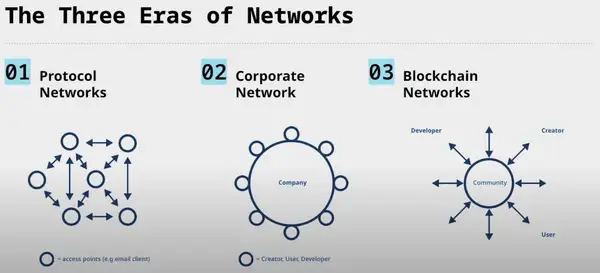
Source: a16z.com
Why is there no community-driven spirit in Web2?
Well, it's not that there's “no” community-driven spirit in Web2; it's just limited. Web2 platforms often start by nurturing communities but become more restrictive over time as they seek to monetize the user base. The initial incentives for cooperation often give way to competitive practices that prioritize the platform's growth over the community's needs. In contrast, Web3 aims to continuously align the interests of the community and the platform. Some notable examples would be Facebook vs. Zynga or Apple vs. Epic Games
Facebook vs. Zynga: In the early days, Zynga thrived by developing games like FarmVille on Facebook's platform. Facebook initially encouraged such third-party game development as it increased user engagement. However, as Facebook evolved, it changed its algorithm to limit the visibility of Zynga games in favour of its content, effectively reducing Zynga's user base and revenue.
Apple vs. Epic Games: Epic Games, the developer of Fortnite, enjoyed substantial success on Apple's App Store until it tried to bypass Apple's in-app purchase system to avoid paying a 30% commission. Apple responded by removing Fortnite from the App Store, which led to a high-profile legal battle.
That said, let's cut to the core of the matter: For many average users, the switch from Web2 to Web3 isn't going to be driven by ideology or even by feature sets. It will be driven by new kinds of experiences that Web3 enables and Web2 simply can't. Imagine playing a game where you can earn tokens and then use those tokens to vote on the game's future development or even spend them on other games or platforms. Think about reading a news article, then directly tipping the journalist via a blockchain, cutting out the publisher and its cut of the profits. These are fundamentally different interactions than what most Web2 platforms offer.
In sum, Web3's potential appeal for the end-user is less about fixing what's ‘broken' with Web2 and more about enabling new kinds of internet experiences that Web2 can't provide. Web3 isn't just a ‘better' Web2; it's a different playing field altogether.
Who Are the Biggest Investors in Web3?
This section is all about “not reinventing the wheel” in a way. Especially if you are new to the web3 space, why not leverage what is already available. All of these VC funds and individual investors on the list below have years of expertise in investing in upcoming ventures and promising projects. They also have big analyst teams that constantly search through the whole ecosystem for the next gem, something you alone could never do. Moreover, they are also very open about their investments a lot of times and publicly disclose them on their websites.
- Andreessen Horowitz (a16z): Known for their early investments in tech giants like Facebook, Airbnb, and Coinbase, a16z has a dedicated crypto fund aimed at investing in blockchain and Web3 projects. They have invested in a range of Web3 initiatives, from infrastructure to decentralized applications (dApps).
In the example of the first and biggest web3 investor in the space, we will show you how to search their website for projects to invest in. You find their portfolio page, select “Crypto”, and choose the stage. Then you look if the project has a coin, and voila, you can also invest in the project like the big investors; that’s the beauty of web3 in a way: no need to wait for an IPO. In this case, you could invest in projects like compound, avalanche, chia, arwave, celo. You can repeat this process with many of the funds below.
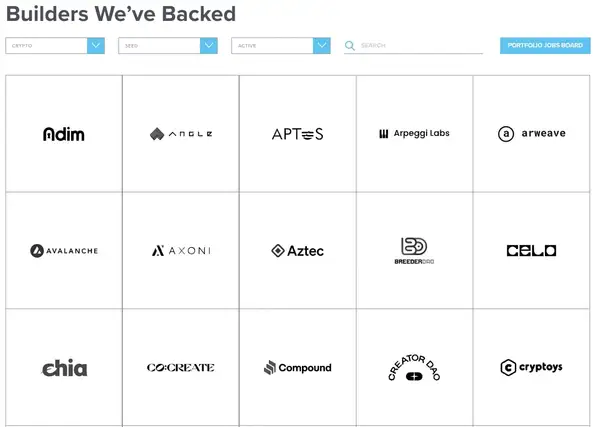
- Paradigm: Founded by Coinbase co-founder Fred Ehrsam and former Sequoia Capital partner Matt Huang, Paradigm specializes in crypto investments. They focus on both early-stage startups and established projects in the Web3 and DeFi spaces.
- Polychain Capital: Founded by Olaf Carlson-Wee, the first employee at Coinbase, Polychain Capital was one of the earliest venture capital firms to specialize in crypto assets. They have a diverse portfolio that includes key Web3 infrastructure projects.
- Pantera Capital: Another major player in the crypto investment scene, Pantera has a broad portfolio that includes blockchain technologies and tokens central to the Web3 vision.
- Union Square Ventures: Known for their early investments in Web2 companies like Twitter and Tumblr, Union Square Ventures has started to pivot towards blockchain and Web3, acknowledging the disruptive potential of these technologies.
- Coinbase Ventures: The investment arm of the prominent cryptocurrency exchange Coinbase has actively invested in various blockchain projects that are fundamental to the Web3 ecosystem.
- Balaji S. Srinivasan: A former CTO of Coinbase and a general partner at Andreessen Horowitz, Balaji Srinivasan is a well-known proponent of Web3, cryptocurrencies, and decentralized technologies. He frequently speaks on these topics and is an active angel investor in the space.
- Tim Draper: A veteran investor in the tech world, Tim Draper has been a prominent supporter of cryptocurrencies and blockchain technology. His firm, Draper Associates, has invested in several Web3 projects.
- Brian Armstrong: As the CEO of Coinbase, Brian Armstrong has been an active investor in the blockchain and crypto space. His influence extends beyond Coinbase and Coinbase Ventures, though, as he regularly organises dinners and invests in various Web3 projects by himself that he thinks might be promising even though they are not a perfect fit for Coinbase Ventures.
However, you do not need to use the ranking we provide; you can also use other websites, such as cryptorank and create your own list.
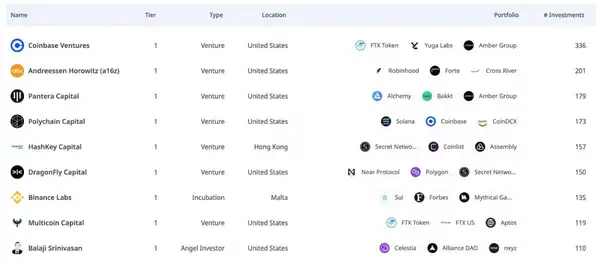
Another way is to search for the first buyers of new coins listed on Uniswap because these first buyers will often be some of the fastest or smartest traders on-chain. You can do it on Arkham; they have a nice thread explaining how to do it.

Finally, there will be a platform released soon by Messari that will let you see the biggest investors in the crypto/web3 space and also which investors have co-invested with each other. Here is a preview; follow Ryan Selkis to be notified once the platform is released.
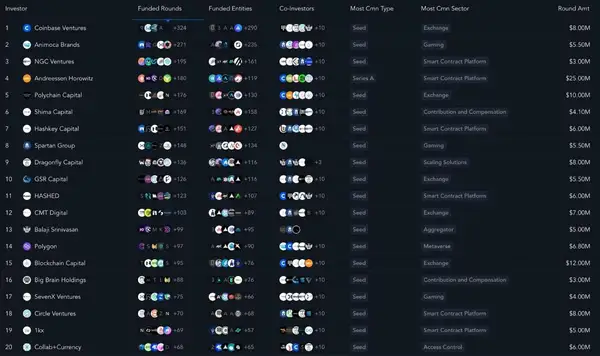
Types of Web3 Investments You Can Choose From
Finally, the part you’ve probably been waiting for: the business side of things. Before we start, one last thing to prepare you for web3. Predicting the next big web3 sensation isn't the same as forecasting in established industries. In mature sectors, you could often peek at a company's balance sheet and make educated guesses. But in emerging arenas like web3, it's all about envisioning and pioneering the future. Consider it a game of strategic bets. A pro tip in the VC world? It's often about the moves you don't make. Obviously, this is not investment advice, but the most successful investors in this industry tend to spread their bets wide and diversify. Yet, here's a crucial distinction to make:
What You Can Invest In: As a retail investor, you're primarily looking at coins or NFTs of certain projects. There's a universe of web3 entities out there, but not all have issued a coin, which means you can't invest in all of them directly.
Case in Point: Yuga Labs, the powerhouse behind Bored Ape Yacht Club and Cryptopunk NFTs. Heavyweight investors like a16z get to back the company. For you? The door's open to Ape Coin and individual NFTs like Bored Apes or Cryptopunks.
But here comes the exciting twist! By the time we explore “Invest in DAOs” later on, you'll unlock strategies to bypass these limitations. You'll be armed with insights to invest with the finesse of heavyweight investors. So, stick around and unfold these golden nuggets.
Invest in Cryptocurrencies
This part is the most straightforward part; you can simply go on your favourite crypto investment platform and buy the coin of the project.
For ideas of what to invest in, we strongly recommend reading our piece on “Crypto Portfolio Allocation.” You will find a comprehensive explanation of the different sectors and different investing strategies.
To give you a glimpse, it might be useful to gain a comprehensive understanding of the industry as a whole. One study conducted by L1 Digital offers an insightful sector mapping of the cryptocurrency market.
Coindesk also provides an alternative perspective on the market. Even for us, it was surprising to see that sectors such as DeFi, Culture & Entertainment, and Computing account for just 5% of the market capitalization of the DACS Sectors. Did you know that?


For easy investing, you can use Morpher, which provides over 70+ cryptocurrencies with high market capitalization.
- Create an Account on Morpher
- Click on ”Cryptocurrencies”
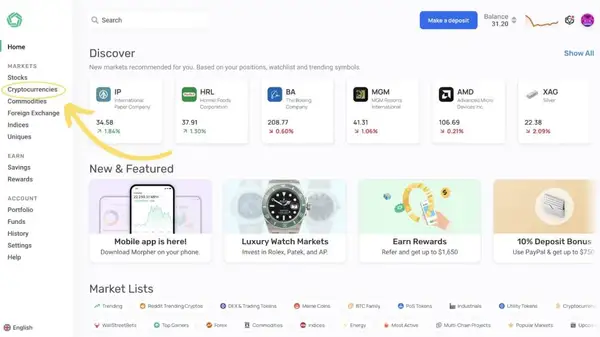
- Pick a cryptocurrency and start investing
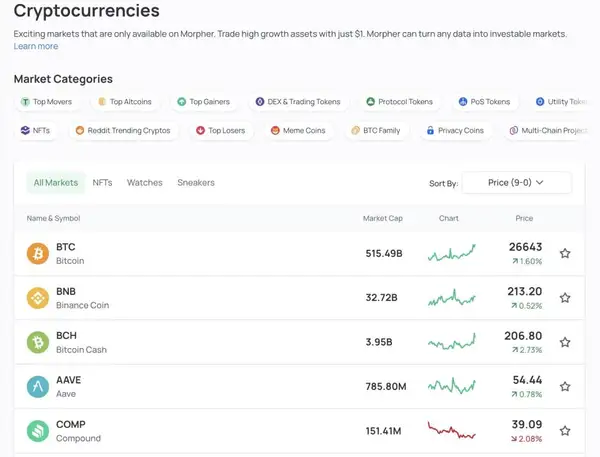
- The cool thing is that you do not need to invest in single projects; in the future, you will also be able to invest in a whole sector, like the DeFi Sector, which combines all of the web3 projects that are contributing to Decentralized Finance.
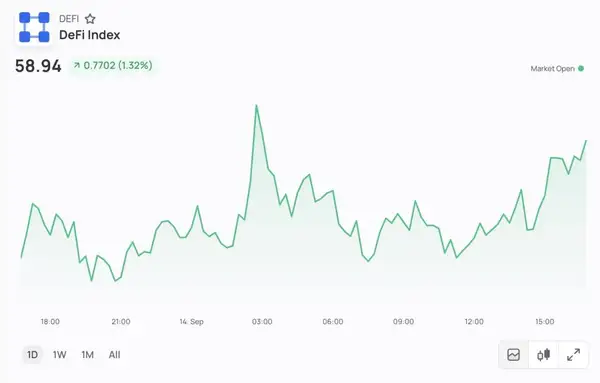
Invest in NFTs (Non-Fungible Tokens)
Now, what about NFTs, aka. digital cryptographic art? You can invest in NFTS in three main ways: buying, minting or trading.
The method used by most people is probably buying an NFT directly from a well-known platform like OpenSea (Rarible, Mintable, SuperRare). It is probably not the best way to achieve the most return on your investment, but it is easy. Here is our quick guide to buy some NFTs:
- Make an account on Opensea
- Set up a digital wallet – an example being MetaMask, which protects your precious digital items. In fact, you can use almost any wallet that works with an ERC-720 contract – also the Morpher Wallet.
- Navigate to a collection and bid or buy the NFT directly.
- Once you get bored of your NFT, you can put it up for auction and wait until someone else buys it.
Another method is minting NFTs. Minting an NFT is sort of the equivalent of creating it. Some early punters minted Cryptopunks for less than 1 ETH. A couple years later, everyone is now asking, “Why are Cryptopunks so expensive?” like they missed out on Bitcoin in 2010.
However, minting is not a guaranteed money maker. It can very well be that you just minted a random piece of an unfamous digital artist. Art and NFTs are all about hype, and you have to anticipate that hype when minting NFTs. For that, good advice would be to follow influencers who are gurus in the industry. Try to follow NFT podcasts that actually know what they are talking about.
Minting 101 Recap:
- Research artists or projects that offer opportunities to mint NFTs.
- Minting refers to the process of creating and tokenizing digital assets as NFTs.
- Keep an eye on announcements and social media platforms to stay informed about new drops.
- Prepare your wallet with the required cryptocurrency and be ready to mint the NFTs as soon as they become available.
On a side note, An interesting platform to search for cheap projects to mint is fxhash. Fxhash is trying to become the world’s foremost generative art hub, where everyone can share, sell, buy and mint their artwork.

Now, there is one problem with these approaches, especially if you’re aiming for option 1, where you buy NFTs directly. If you want to buy the most sought-after pieces, get ready and prepare at least a couple grand!
So, fortunately, if you do not have a couple of thousand grand lying around to spend on NFTs, there is a simpler and better solution. This solution is NFT trading on Morpher. On Morpher, you can trade the esteemed collections mentioned earlier for as little as $1. Moreover, you have the option to trade a whole index, which allows you to profit from major sales rather than relying solely on less sought-after NFTs. Additionally, you can trade NFTs in a manner similar to stocks or currencies, using your favourite technical indicators or candlestick patterns. This creates a never-before-seen tradable market.
You might find it hard to believe, but let us show you the trading charts for NFTs on Morpher.
- Create an Account on Morpher
- Click on ”Unique Markets” and go to “NFTs”
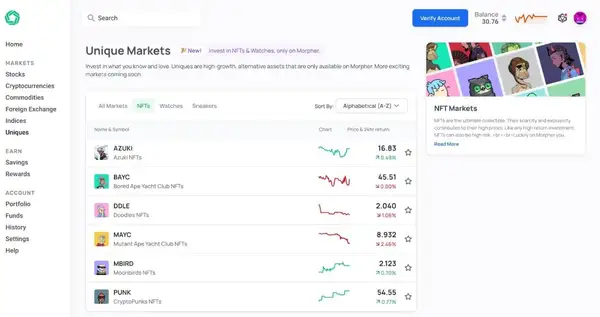
- Pick a collection and start trading
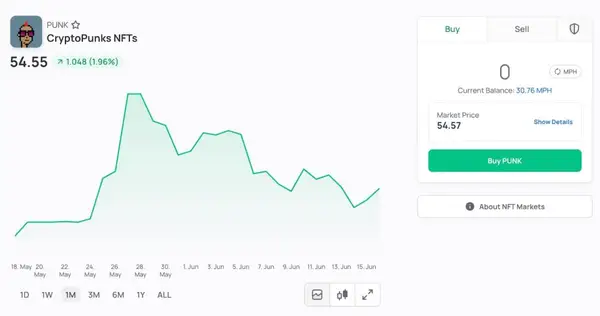
- Trade major collections like Cryptopunks, Zombie Bored Ape Club, and Azukis with various technical indicators and advanced trading charts.
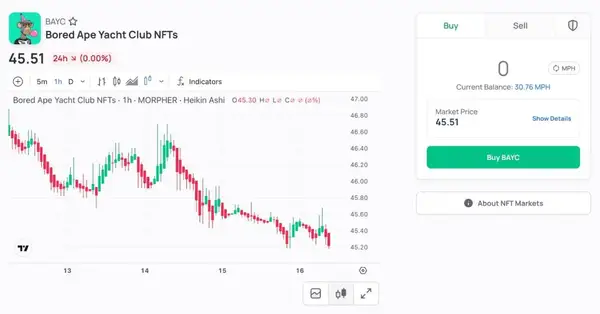
Invest in DAOs (Decentralized Autonomous Organizations)
DAOs are an essential part of web3 and stands for “Decentralized Autonomous Organization.”
To quote a major publication on DAOs by Hassan et al.:
“A DAO is a blockchain-based system that enables people to coordinate and govern themselves mediated by a set of self-executing rules deployed on a public blockchain, and whose governance is decentralised (i.e., independent from central control).”
DAOs are often set up to run collective investment funds, operate decentralized applications, or even steer online communities. The governance of a DAO is transparent, and it's run by smart contracts on a blockchain, which makes it a Web3 native entity.
If that still does not make sense, here is a quote from a quirky DAO called MolochDAO that explains the purpose of their investment DEO quite well:
“MolochDAO is a grant giving decentralized autonomous organization (DAO), where every member has voting power, as opposed to a small group of investors making all the decisions.
As a group of resilient optimists, who laugh in the face of Moloch and display battle scars with pride, members contribute their own capital to fund projects that further the development of public goods in the Ethereum ecosystem.”
Participation usually requires owning some of the DAO's governance token, which may either be purchased or earned by contributing to the project. Here's a simplified step-by-step guide:
- Research & Token: Understand the purpose and rules of the DAO you're interested in and potentially buy the token to vote on proposals.
- Join the Community: Engage with the community through forums, social media, or other communication platforms to keep in the loop.
- Vote or Create Proposals: Use your tokens to vote on existing proposals or create new ones.
- Investing in a DAO gives you a say in decisions related to the project, and it could be financially rewarding if the DAO is successful. However, the decentralized nature also means there's often less regulatory oversight, so due diligence is crucial.
To lead you further down the venture DAO path, you can check out some of them in the picture below. Most of them actually have a vibrant community behind them and successfully invest in projects or even start their own web3 companies together. The differentiating thing about being part of an investing DAO is that they can invest directly into companies and do not have to wait for a coin to be released, meaning you can invest like big institutional investors.
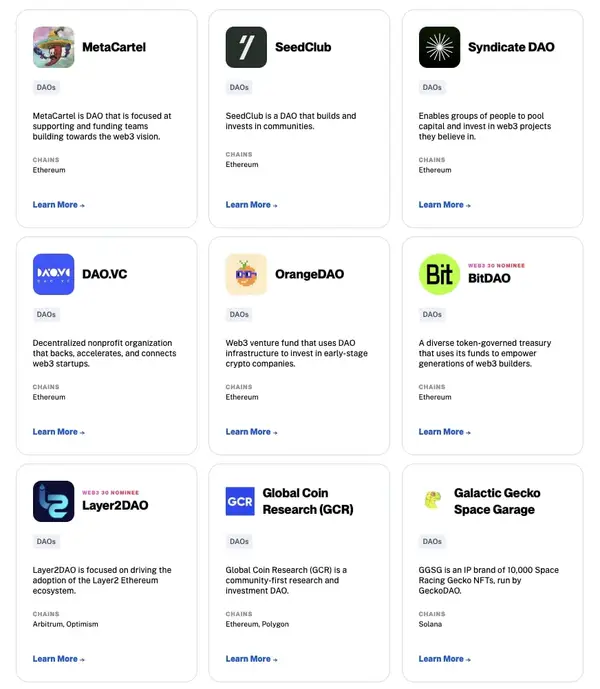
Our favourite is a community called krausehouse, whose plan is to buy a whole NBA team. Isn’t that crazy? Welcome to Web3.

Some Risks and Considerations
This is a blog on investing and that is why we also have to explain some risks to you. Especially in fields like web3, where the technology is new and regulations are not so clear yet, it can be very risky. You basically have to consider two main risks: technological and regulatory. There is always a big chance that the startup or technology will fail. In fact, to quote a research paper by Kalyanasundaram:
“the failure rate of startups is extremely high at 90%”.
Secondly, as we saw with projects like Tornado Cash, you are always up for regulatory risks. That brings us to our last part – due diligence.
Due Diligence: Research Before You Invest in Web3
We cannot stress this enough: please always do your due diligence on a project, or you run a high risk of getting rug pulled. Make use of available tools and resources like whitepapers, community forums, and expert analyses to make an informed decision. Here is our minimal checklist of 5 points:
- Research the Team
- Read the Whitepaper
- Check Community Engagement
- Audit Smart Contracts
- Financial Transparency
To tackle this checklist, you can use various platforms to support your research. These platforms cannot only help you to track smart money but also get a feeling for the legitimacy of the web3 project. Nansen, Dune Analytics, CryptoRank and Arkham offer tools to track and analyze blockchain activity.
Conclusion: The Future of Web3 is Bright!
In summary, the future of crypto holds immense promise, attracting brilliant minds and fostering cultural shifts. While we cannot provide definitive answers, seeking insights from reputable sources will help us understand potential web3 developments and navigate the exciting possibilities that lie ahead.
What we know for sure is that web3 offers a wealth of product options and opportunities for experimentation and that as we move forward, staying informed, remaining open-minded, and engaging with the web3 community will help us navigate the industry’s dynamic nature. While we cannot predict the future, we can anticipate continued growth, innovation, and transformative ideas shaping the future of web3. That brings us to the end of our comprehensive guide on how to invest in web3, and as we started this article with a quote from Chris Dixon, we also shall end it with one:
“But the same creative patterns that happened in the 2000s live on today, driven by enthusiasts who see possibilities where others don’t. You just need to know where to look. My belief is that the best place to look is crypto and web 3.”
Chris Dixon

Disclaimer: All investments involve risk, and the past performance of a security, industry, sector, market, financial product, trading strategy, or individual’s trading does not guarantee future results or returns. Investors are fully responsible for any investment decisions they make. Such decisions should be based solely on an evaluation of their financial circumstances, investment objectives, risk tolerance, and liquidity needs. This post does not constitute investment advice.

Painless trading for everyone
Hundreds of markets all in one place - Apple, Bitcoin, Gold, Watches, NFTs, Sneakers and so much more.

Painless trading for everyone
Hundreds of markets all in one place - Apple, Bitcoin, Gold, Watches, NFTs, Sneakers and so much more.

